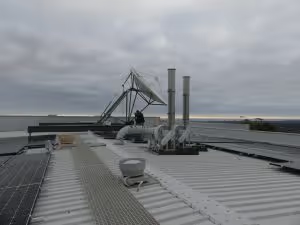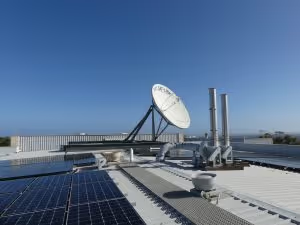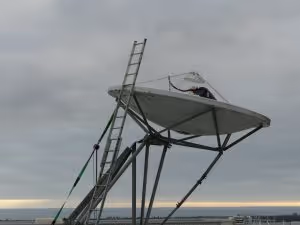Back on air!

In the last post, I explained how we hit a snag, with our partners being forced to shutdown their satellite beam over the Western Pacific, where our testing is focussed. This has now been solved, and we have a beam active again covering our areas of interest. This has been a very interesting learning exercise for us, as it has involved us establishing a complete satellite ground station on the University campus.
It is worth explaining why we opted to run the ground station ourselves from the University campus, instead of using a commercial teleport. There are basically two interlinked reasons for this:
[caption id="attachment_11307" align="alignright" width="300"]

- The University's old ground station (dish), before being put back into service[/caption]
First, it will be cheaper in the long run, because we will not have to pay any teleport fees for operation. This will help us to reduce the cost of operating the service, and also means that we can more easily activate and deactivate the service during the remaining stages of development. This will cut operating costs by about 20%. - Second, it gives us more control over the operation of the service, which will allow us to keep on innovating. The challenge is the cost of establishing a ground station, which involves the physical installation of a big satellite dish - often 4 to 6 metres in diameter, and the not insignificant ground or building works to mount it on, because a 6 metre umbrella catches a lot of wind! Building the dish can cost tens of thousands of pounds, but fortunately, we had an old unused dish from a 1990s research project.
[caption id="attachment_11305" align="alignleft" width="300"]

There were some repairs to be done, so the dish had to be pointed up, so that the engineer could get into it to fix it.[/caption]
A lot of time has passed since the 1990s, however, and the dish was showing signs of wear from the elements. The main challenge was that all the adjusting bolts were a bit seized up, and the feed horn's protective mylar cover had been damaged at some point, allowing rain, spiders and other unhelpful things to get into the electronics, which thus needed replacing.
As the dish is quite old, it was a little complicated to find the necessary spare parts, but since the alternative was spending perhaps £10,000 - £20,000 for a new dish, this was a complication we were willing to live with. This required tipping the dish back, so that it would be safe and practical to get into the dish itself to replace various parts. Also, whatever satellite the dish was originally pointing at is probably no longer in orbit, and so we had to get the dish pointed in the correct direction. The nice folks from SpeedCast did a great job of tackling all this, including finding spare parts from a dish of the same model that they had decommissioned at their ground station.
[caption id="attachment_11306" align="alignright" width="300"]

Spot the difference: The dish is now pointed at the correct satellite, and back in service after almost 25 years[/caption]
Complex projects often raise issues that you would not have otherwise thought about. In our case, something as simple as where the DC bias and clock reference for the satellite dish electronics fell through the cracks for a couple of weeks, because this is usually provided by the ground station - but we didn't realise this until some way into the process. This was easy and cheap to fix, but served as an example of the things you don't initially think of when undertaking something for the first time.
The process of getting the satellite bandwidth allocated was also interesting, because the service we are creating is not at all typical. Our partners at Outernet are fortunately experienced with dealing with this sort of problem, and after only a short delay, we had the allocation made.
So, finally some months later than we had hoped, we now have a ground station transmitting the signals we need to the correct satellite. The next step, and one which will hopefully happen in the next week or so, is to begin receiving those signals from the prototype receiver.
Stay updated
Sign up for our newsletter to receive regular updates on resources, news, and insights like this. Don’t miss out on important information that can help you stay informed and engaged.
Explore Elrha
Learn more about our mission, the organisations we support, and the resources we provide to drive research and innovation in humanitarian response.